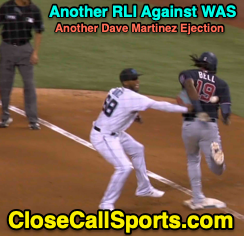What happens when a team's TV broadcast doesn't see a play or know a rule? Unfortunately, as was the case with a Chicago Cubs vs White Sox game featuring Hawk Harrelson in 2007, it often results in derision of the umpires, even when the umpires get the call right. Joe West may have ejected Ozzie Guillen after just such a play, but even after the game, both indicated a shared understanding about what had transpired.
With none out and runners on first and second base in the top of the 8th inning of the Cubs-White Sox June 24, 2007 matinee, Cubs batter Mark DeRosa hit a fly ball to deep right field.
If you watched the White Sox broadcast, it went something like this: Hit to the outfield, yada yada yada, Sox tag out two Cubs runners with bad base-running for a double play. 2B Umpire Ed Rapuano called baserunner R1 Angel Pagan out and HP Umpire CB Bucknor called R2 Felix Pie out. Umpires discuss it, inexplicably load the bases and take the outs off the board, and Joe West ejects Ozzie Guillen because in a few year's time, Joe will become a joke to the umpiring profession.
In other words, the Sox were bewildered by the play in front of them, assured their TV audience that they saw everything and the umpires missed something, and that the call was incorrect and egregiously so. After all, replays shown on the Sox broadcast clearly indicated that two runners were tagged out.
If you watched the Cubs broadcast, on the other hand, it went something like this: Hit to the outfield, Cubs runner R1 Pagan runs into White Sox shortstop Juan Uribe who was standing on second base for some reason even though the ball was still in right field, Pagan gets up and runs to third, spurring lead baserunner R2 Pie to run toward home plate, all manners of rundowns ensue, and the White Sox tag two runners, but wait, the umpires will fix it after the play is over.
During their post-play analysis, the Cubs' cast identified the obstruction as well as 2B Umpire Rapuano calling it (and showed a second angle in which 3B Umpire Ed Hickox also called it). For the record, this was a case of Obstruction Type B / Type 2. Official Baseball Rule 6.01(h)(2) states: "If no play is being made on the obstructed runner, the play shall proceed until no further action is possible. The umpire shall then call 'Time' and impose such penalties, if any, as in his judgment will nullify the act of obstruction."
The umpires allowed play to conclude then ruled that had obstruction not occurred, the most likely outcome would be bases loaded, none out, as the obstruction impeded or disoriented the runner from seeing the base coach/lead runner or having the wherewithal to remain on second base.
After the game, ejected White Sox manager Ozzie Guillen said of West's crew, "I think they got it right," while Crew Chief Joe West said of Guillen, "You can't blame him. It was a messed-up play that you don't see very often. Uribe is not known for trying to cheat or get in somebody's way, but it happens. He got two outs and he ended up getting no outs and that's why Ozzie said, 'You're just going to have to run me.'
In conclusion, sometimes the broadcast gets it right and sometimes it does not. The purpose of this video is to show how sometimes even a TV broadcast with all of its replays and cameras can miss the crucial element of an entire play and how sometimes the analysis broadcast to the public is therefore inaccurate or misleading.
Postscript: Perhaps most egregious of all is that the White Sox feed showed a replay featuring a camera angle (and maybe two) that would have shown the obstruction, but the replay was started from a point AFTER the obstruction had already occurred. Was this simple negligence or deliberate omission of a material fact?
Video as follows:


























